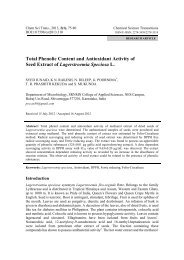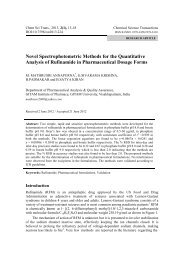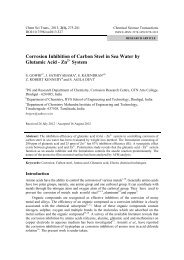Full Text - Chemical Science Transactions
Full Text - Chemical Science Transactions
Full Text - Chemical Science Transactions
You also want an ePaper? Increase the reach of your titles
YUMPU automatically turns print PDFs into web optimized ePapers that Google loves.
416 Chem Sci Trans., 2013, 2(2), 413-422<br />
kept it for an hour. The holocellulose residue was filtered and transferred to the crucible and<br />
washed with 100 mL of 8.3% sodium hydroxide, 200 mL of distilled water, 15 mL of 10%<br />
acetic acid and with water, successively. The crucible with α-cellulose was dried and<br />
weighed.<br />
Hemicellulose content<br />
The hemicellulose content of abaca fiber was determined by calculating the difference<br />
between holocellulose and α-cellulose 5,19 .<br />
Alkali treatment of fiber<br />
The fibers are first dewaxed by soaking in 1:2 mixtures of ethanol and benzene for 72 h,<br />
followed by washing with deionised water and then air dried. The dewaxed fibers were<br />
immersed in 5, 10, 15% NaOH solution, where the total volume of the solution was 15 times<br />
the weight of the fibers. The fibers were kept in alkaline solution for 72 h at room<br />
temperature; they were thoroughly washed in running water and then neutralized with 2%<br />
acetic acid solution. Lastly, the fibers were washed again in running water to remove the last<br />
traces of acid sticking to it, so that the pH of the fibers was approximately 7. Then, they<br />
were dried at room temperature for 48 h to obtain alkali-treated fibers 5 .<br />
Acrylic acid treatment of fiber<br />
Alkali treated abaca fiber was soaked in 5% acrylic acid (AA) solution at 50 o C for 1 h,<br />
then washed with distilled water thoroughly and dried in an oven for 24 h at the<br />
temperature of 70 o C 31 .<br />
Water absorption studies<br />
The study of water absorption on untreated and acrylic acid treated fibers were carried out in<br />
water from various sources such as pond water, borewell water, river water & sea water. The<br />
pH values of water samples were, pond water: 8.20, borewell water: 7.40 river water: 7.74,<br />
sea water: 7.76. Humidity chambers (desiccators) were set up at 100% humidity using water<br />
from various sources. The specimens were prepared from bundles of single fibers bound<br />
together. The specimens (untreated and acrylic acid treated abaca fiber) were dried in hot air<br />
oven at 60 o C for 24 h, weighed on a balance accurate to 4 decimal places (±0.1 mg) and<br />
were then placed in the humidity chamber. The humidity chamber was held at room<br />
temperature. After 24 h, each fiber bundle was taken out of the humidity chamber and<br />
excess water was carefully mopped with filter paper. Finally, the weight of the fibers was<br />
measured and the MC was calculated by weight difference. Then again the sample is<br />
immersed in water and the same process is repeated after every 24 h till 2400 h. A graph is<br />
plotted between the percentage of moisture content and square root of immersion time.<br />
ma − md<br />
MC = x100%<br />
m<br />
Where MC is the moisture content, m a is the mass of the sample after exposing to<br />
moisture and m d is the mass of the dry sample. More details about the technique can be<br />
found in the literature 5,32-34 .<br />
Morphological study<br />
Scanning electron microscopic (SEM) photographs of untreated, alkali treated and acrylic<br />
acid treated abaca fibers were obtained with a JEOL JSM-T330A scanning electron<br />
microscope at the accelerating voltage of 20 KV.<br />
a





